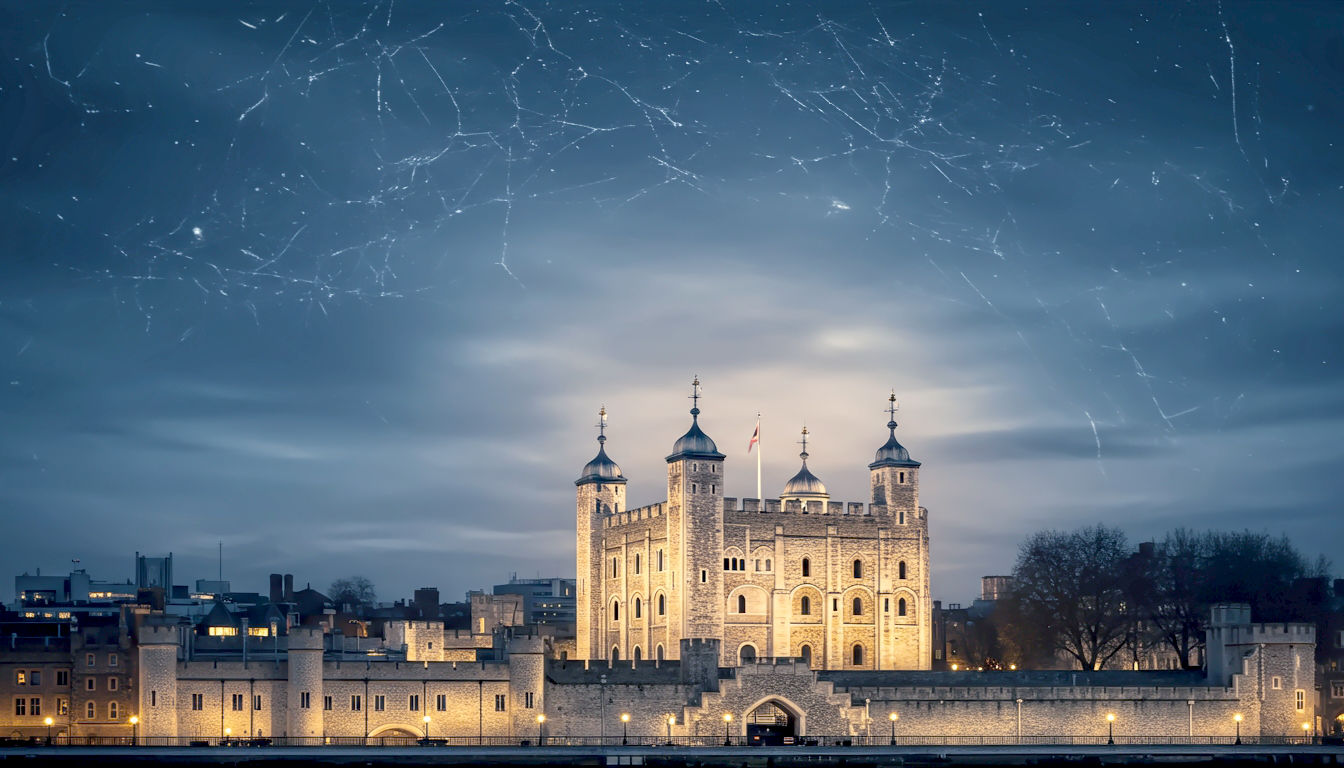The Tower of London: A Time Capsule of British History
Explore Britain’s most iconic castle. Uncover stories of kings, queens, prisoners, and the famous Beefeaters in this ultimate guide to the Tower of London.

This post may contain affiliate links. If you make a purchase through these links, we may earn a commission at no additional cost to you.
Standing guard over London for nearly a thousand years, the Tower of London isn’t just an old castle; it’s a stone diary of Britain’s story. If its walls could talk, they’d tell tales of kings and queens, secret plots, dazzling jewels, and even a polar bear that once lived by the River Thames.
It began as a fearsome fortress to keep rebellious Londoners in check and grew into a royal palace, a notorious prison, a zoo, and the secure home of the nation’s most precious treasures. Forget what you think you know about dusty old buildings. The Tower is where history comes alive, with stories of bravery, betrayal, and mystery etched into every single stone. It’s not just a landmark; it’s the heart of Britain’s history, still beating strong today.
William the Conqueror’s Great Stone Keep: The Birth of the Tower
Why Build a Castle Here?
To understand why the Tower of London exists, we need to pop back to 1066. A French duke named William sailed across the English Channel, won the Battle of Hastings, and became King of England. But the Londoners weren’t exactly thrilled about their new foreign ruler. William the Conqueror, as he became known, knew he needed to stamp his authority on the city and fast. He needed a fortress that screamed, “I’m in charge here, so don’t even think about starting a rebellion.”
He chose a strategic spot on the north bank of the River Thames. It was perfect. The Romans had already built a defensive wall there, so he could use that as a starting point. More importantly, anyone sailing up the Thames—the main motorway into London back then—would see his mighty castle and know who was boss. It was a power move, a clear and terrifying message to anyone who dared challenge him.
The White Tower: A Norman Masterpiece
Construction didn’t start with the whole complex you see today. It began with the most famous part: the White Tower. Around 1078, William brought over a Norman monk named Gundulf, who was a brilliant architect, to oversee the project. They used a special pale stone imported from Caen in France, which gave the tower its brilliant white appearance and its name.
For its time, the White Tower was a beast of a building. It was huge, nearly 30 metres tall, with walls that were a whopping 4.5 metres thick at the base. It wasn’t just built for show; it was designed for war. The entrance was on the first floor, reached by a wooden staircase that could be quickly removed if enemies attacked. Inside, it was a mix of practical living quarters for the king and his court, a grand banqueting hall, and, deep in the basement, a dark, gloomy dungeon.
At the very top, under one of the turrets, was St John’s Chapel. It’s a beautiful and surprisingly peaceful space, a stunning example of early Norman church architecture that has survived almost untouched for over 900 years. It’s a little slice of Norman France right in the heart of London.
The White Tower took over 20 years to complete and set the standard for castle-building across England. It was a symbol of Norman power that was impossible to ignore.
More Than Just a Fortress: Palace, Prison, and Powerhouse
The Tower wasn’t just a military stronghold for long. Its role twisted and turned with the tides of British history, becoming much more than William the Conqueror ever imagined.
From Royal Residence to Royal Retreat
For centuries, the Tower was one of the most important royal palaces in England. Kings and queens didn’t just visit; they lived here. They expanded the complex, adding more comfortable living quarters, gardens, and courtyards. King Henry III and his son, Edward I, were massive builders, adding the defensive outer walls and the 13 towers we see today, like the Wakefield and St Thomas’s Towers.
It became a tradition for monarchs to stay at the Tower before their coronation. They would travel in a grand procession from the Tower through the city streets to Westminster Abbey to be crowned. Imagine the excitement and spectacle as the new king or queen emerged from behind those imposing walls to greet their people for the first time. This tradition continued for hundreds of years, cementing the Tower’s place at the centre of royal life.
The Tower as a Prison: A Place of Fear and Infamy
While it was a home for royalty, the Tower of London is probably more famous for being a prison. But it wasn’t your average jail for common criminals. Its prisoners were high-status individuals—fallen nobles, failed plotters, and even kings and queens who had fallen out of favour. Being sent to the Tower was a terrifying prospect. It meant you were considered a major threat to the state.
The conditions varied wildly. If you were wealthy and well-connected, you might live in relative comfort in one of the larger tower rooms, allowed your own furniture, books, and servants. You might even be allowed to walk in the grounds. But for others, it was a grim experience, locked away in cold, dark cells.
The phrase “sent to the Tower” became a chilling expression, often meaning a one-way trip. While thousands were imprisoned here over the centuries, fewer than 25 people were actually executed inside the Tower walls. Public executions were held on nearby Tower Hill to draw huge crowds, but a private execution within the Tower was reserved for those whose public death might cause a riot or prove too embarrassing. These were often the most famous cases.
The Menagerie: Lions, Tigers, and a Polar Bear
One of the most surprising roles of the Tower was as London’s first zoo. For over 600 years, it housed a collection of exotic animals given as gifts to the monarch from rulers around the world. It all started in the 1200s when King John kept lions there.
Soon, other animals arrived. King Henry III was given three leopards (often mistaken for lions) by the Holy Roman Emperor, in a nod to the three lions on his coat of arms. But perhaps the most famous resident was a polar bear, a gift from the King of Norway in 1252. The bear was kept on a long chain so it could swim and catch fish in the River Thames, which must have been an incredible sight for Londoners.
There were elephants, tigers, eagles, and all sorts of strange and wonderful creatures. The Royal Menagerie was hugely popular, but by the 1830s, conditions were considered unsuitable. The remaining animals were moved to a new, purpose-built home, which we now know as London Zoo in Regent’s Park.
The Crown Jewels: A Dazzling Display of Royal Power
Deep within the Tower, protected by bomb-proof glass and state-of-the-art security, lies one of the world’s most valuable and breathtaking collections of treasures: the Crown Jewels. This isn’t just a pile of sparkly gems; it’s a working collection of royal regalia, symbols of the British monarchy’s power, history, and continuity for over 800 years.
What Are the Crown Jewels?
The collection includes crowns, sceptres, orbs, swords, and robes used in royal ceremonies, most importantly, the coronation. When a new monarch is crowned, these very objects are used to formally invest them with their power and responsibilities.
Sadly, the original set of medieval Crown Jewels was almost entirely destroyed in 1649 during the English Civil War. After the monarchy was abolished, Oliver Cromwell ordered the treasures to be melted down or sold off, declaring them symbols of the “detestable rule of kings.”
When King Charles II was restored to the throne in 1660, one of his first tasks was to remake the lost jewels. Most of the pieces you see today date from his reign, making them over 350 years old.
Stars of the Show
While the entire collection is stunning, a few pieces really steal the limelight:
- St Edward’s Crown: This is the big one. Made of solid gold and weighing nearly 2.3kg (that’s heavier than a bag of sugar!), it’s the crown used at the precise moment of crowning. Because it’s so heavy, the monarch only wears it for a short time during the ceremony.
- The Imperial State Crown: This is the crown the monarch wears after the coronation ceremony and for major state events like the Opening of Parliament. It’s absolutely covered in famous gems, including the Cullinan II diamond, a massive 317-carat stone. It also features the Black Prince’s Ruby (which is actually a spinel), worn by King Henry V at the Battle of Agincourt.
- The Sovereign’s Sceptre with Cross: This sceptre holds the world’s largest cut white diamond, the Cullinan I, also known as the Star of Africa. It weighs an incredible 530 carats. It was so large that the sceptre had to be redesigned to hold it.
The jewels are a powerful symbol of the monarchy. They represent not just immense wealth, but the history, duty, and tradition that the Crown embodies. Their home in the Tower of London, guarded day and night, reminds everyone of their priceless importance to the nation.
Famous Faces of the Tower: Prisoners and Residents
The history of the Tower is woven with the life stories of some of the most famous figures in British history. From queens who lost their heads to explorers who charted the world, these are the people who left their mark on the fortress.
The Princes in the Tower: A Royal Mystery
One of the darkest and most enduring mysteries of the Tower concerns two young boys: King Edward V, aged 12, and his younger brother, Richard, Duke of York, aged 9. After their father, King Edward IV, died in 1483, the boys were brought to the Tower, supposedly to prepare for Edward’s coronation.
Their uncle, Richard, Duke of Gloucester, was named their protector. But he quickly declared the boys illegitimate, seized the throne for himself, and became King Richard III. The two princes were seen playing in the Tower gardens for a short while, but then they vanished. They were never seen again.
What happened to them? The most popular theory, championed by Shakespeare, is that Richard III had them murdered to secure his claim to the throne. In 1674, workmen discovered a wooden chest containing the skeletons of two small children buried beneath a staircase in the White Tower. They were believed to be the lost princes and were given a royal burial in Westminster Abbey. But to this day, no one knows for sure what really happened.
Anne Boleyn: The Queen Who Lost Her Head
Perhaps the most famous prisoner of the Tower is Anne Boleyn, the second wife of the infamous King Henry VIII. When she failed to provide him with a male heir and he fell in love with Jane Seymour, Henry needed a way out of the marriage.
Anne was arrested on trumped-up charges of treason, adultery, and even incest. She was tried and found guilty, though most historians agree she was innocent. Henry, perhaps as a final, small act of mercy, spared her the gruesome executioner’s axe. Instead, he hired an expert swordsman from France to ensure a swift, clean death.
On 19 May 1536, Anne was executed on a private scaffold on Tower Green, away from the jeering crowds. She is buried in the Chapel of St Peter ad Vincula within the Tower, alongside two other of Henry VIII’s wives who met a similar fate: Catherine Howard and Lady Jane Grey, the “Nine Days’ Queen.”
Sir Walter Raleigh: The Explorer Who Spent 13 Years Imprisoned
Sir Walter Raleigh was a classic Elizabethan adventurer—a dashing courtier, poet, explorer, and favourite of Queen Elizabeth I. But his fortunes changed under her successor, King James I. Raleigh was accused of plotting against the new king and was imprisoned in the Tower.
He ended up spending 13 years locked away. But he made the most of it. He lived with his family in the Bloody Tower, where he grew exotic plants like tobacco from his travels, conducted scientific experiments, and wrote his famous book, The History of the World.
He was eventually released to lead one last expedition to find the mythical city of El Dorado in South America. When the trip failed, his old treason charge was reinstated, and he was finally beheaded at Westminster in 1618.
Guy Fawkes: The Gunpowder Plotter
Everyone knows the rhyme: “Remember, remember the fifth of November, Gunpowder, treason and plot.” After the failure of the Gunpowder Plot in 1605, Guy Fawkes and his co-conspirators were brought to the Tower.
Fawkes was interrogated and tortured in the dungeons of the White Tower until he gave up the names of his fellow plotters. The famous “confession” he signed shows his signature as a weak, barely legible scrawl, a testament to the brutal treatment he endured. He was later tried and executed, and his story became a permanent part of British folklore.
The Guardians of the Tower: Beefeaters, Ravens, and Traditions
The Tower of London is steeped in ceremony and tradition, much of it carried out by its famous residents and guardians.
The Yeoman Warders (Not Beefeaters!)
They are one of the most iconic sights in Britain. Dressed in their splendid Tudor-style uniforms, the Yeoman Warders are the official guardians of the Tower. Many people call them “Beefeaters,” a nickname whose origins are a bit of a mystery. Some say it came from the fact that they were allowed to eat as much beef as they wanted from the king’s table—a huge luxury back in the day.
But becoming a Yeoman Warder isn’t easy. You can’t just apply for the job. To be eligible, you must have served for at least 22 years in the British armed forces, reached a senior rank, and hold the Long Service and Good Conduct medal. It’s a role filled with immense pride and tradition.
Today, their role is mostly ceremonial and they act as fantastic tour guides, sharing the Tower’s stories with millions of visitors. But they are still the official bodyguards of the monarch when they visit the Tower. And yes, they and their families actually live inside the Tower walls, making it a living, breathing community.
The Ravens: Protectors of the Crown
Another famous legend revolves around the Tower’s resident ravens. There are always at least six ravens living at the Tower, and they are treated like royalty. The legend says that if the ravens ever leave the Tower, the kingdom will fall.
No one is quite sure where the story came from, but it’s thought to have started during the reign of King Charles II. He was apparently told of the prophecy and, not wanting to take any chances, decreed that there must always be six ravens at the Tower.
To make sure they don’t fly away, their wings are carefully trimmed by the Ravenmaster, one of the Yeoman Warders who is specially responsible for their care. The ravens are official members of the garrison and can even be dismissed for bad behaviour! They are a beloved and essential part of life at the Tower.
The Ceremony of the Keys
Every single night, for the last 700 years, the Tower of London has been locked up in a formal ceremony known as the Ceremony of the Keys. It’s the oldest surviving military ceremony in the world.
At exactly 9:53 PM, the Chief Yeoman Warder emerges, carrying a lantern and the Queen’s Keys. He meets the Tower Guard and they proceed to lock the main gates. As they walk, they are challenged by a sentry who calls out, “Halt! Who comes there?” The Chief Warder replies, “The keys.” The sentry asks, “Whose keys?” And the Chief Warder declares, “Queen Elizabeth’s keys.” The guard then allows them to pass, saying, “Pass, Queen Elizabeth’s keys. All’s well.”
A trumpeter plays the Last Post, and the keys are delivered to the Resident Governor. The ceremony has never been cancelled, not even during the World Wars, though it was once delayed when a bomb fell nearby. It’s a powerful daily reminder that the Tower is still a working fortress.
The Tower Today: A World Heritage Site
Today, the Tower of London is one of the most popular tourist attractions in the world, welcoming millions of visitors each year. It’s no longer a place of fear but one of fascination. In 1988, it was named a UNESCO World Heritage Site, recognising its immense importance to global history.
Visiting the Tower is like stepping back in time. You can walk the same battlements where medieval soldiers stood guard, see the graffiti carved into cell walls by prisoners hundreds of years ago, and stand in the very rooms where kings and queens shaped the future of the nation.
It continues to be a living piece of history, managed by the independent charity Historic Royal Palaces. It still has its official garrison of soldiers, and it’s still the secure home of the Crown Jewels. The ancient traditions, from the Ceremony of the Keys to the care of the ravens, continue unbroken.
The Tower of London has been a silent witness to almost a millennium of British history. It has survived wars, fires, and plots, constantly changing its role but always remaining at the heart of the nation’s story. It is more than a castle; it is a powerful symbol of Britain’s past and a timeless monument that continues to captivate us all.
Further Reading
For those wishing to delve deeper into the Tower’s fascinating history, these resources are highly recommended:
- Historic Royal Palaces: The official website and ultimate authority on the Tower of London.
- English Heritage: Offers a wealth of information on the Tower and other historic sites across England.
- The Royal Collection Trust: The official home of the Crown Jewels, with detailed histories of each item.
- British History Online: A digital library containing primary and secondary sources for the history of London and the Tower.






